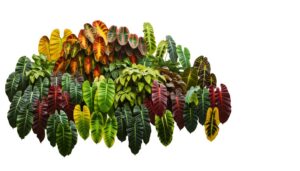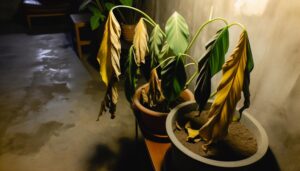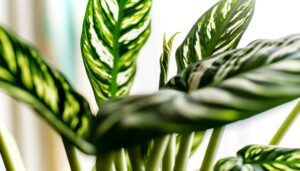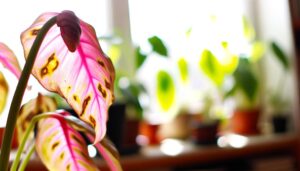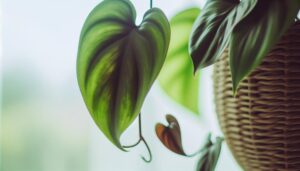What Is the Best Pot Size for a Pink Princess Philodendron?
For peak growth, a Pink Princess Philodendron requires a pot size that accommodates moderate root expansion. A pot with a diameter of 6 to 8 inches is ideal, balancing room for root growth without leading to root-bound conditions.
Ensuring multiple drainage holes in the pot is critical to maintain root aeration and prevent waterlogging. The selected pot's material should align with your environmental conditions; terracotta offers superior aeration, while plastic retains moisture effectively.
Periodic repotting is recommended to avoid soil degradation and physiological stress in the plant. To uncover further intricate details about potting principles, continue learning.
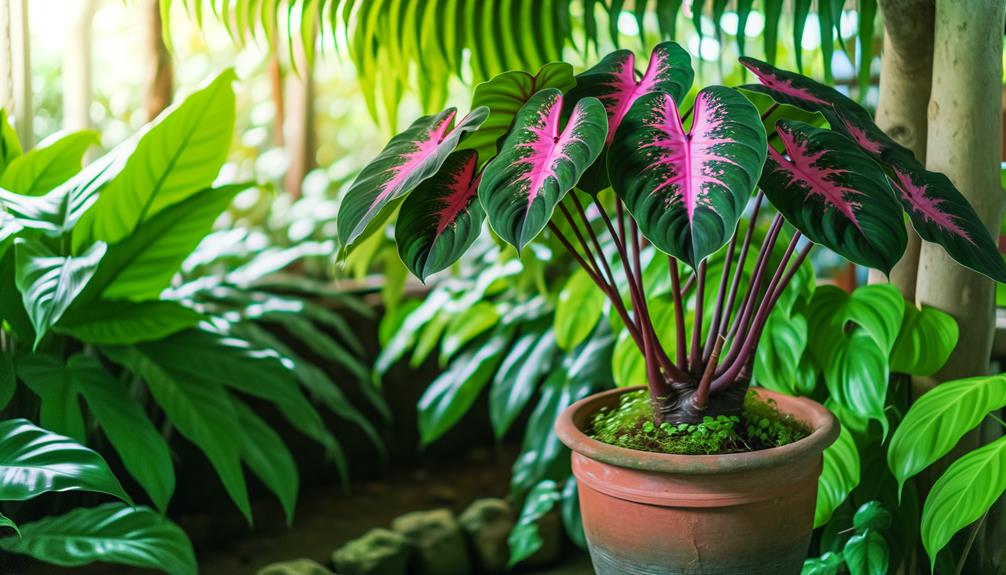
Key Takeaways
- A 6 to 8-inch pot diameter provides optimal room for Pink Princess Philodendron root expansion.
- Ensuring room for incremental root growth prevents root-bound conditions and promotes plant health.
- Proper drainage is essential; select pots with multiple drainage holes to avoid waterlogging.
- Periodically reassessing root space ensures continued healthy development and prevents soil compaction.
- Choose pot material based on environmental conditions; terracotta enhances aeration, while plastic retains moisture effectively.
Understanding Root Growth
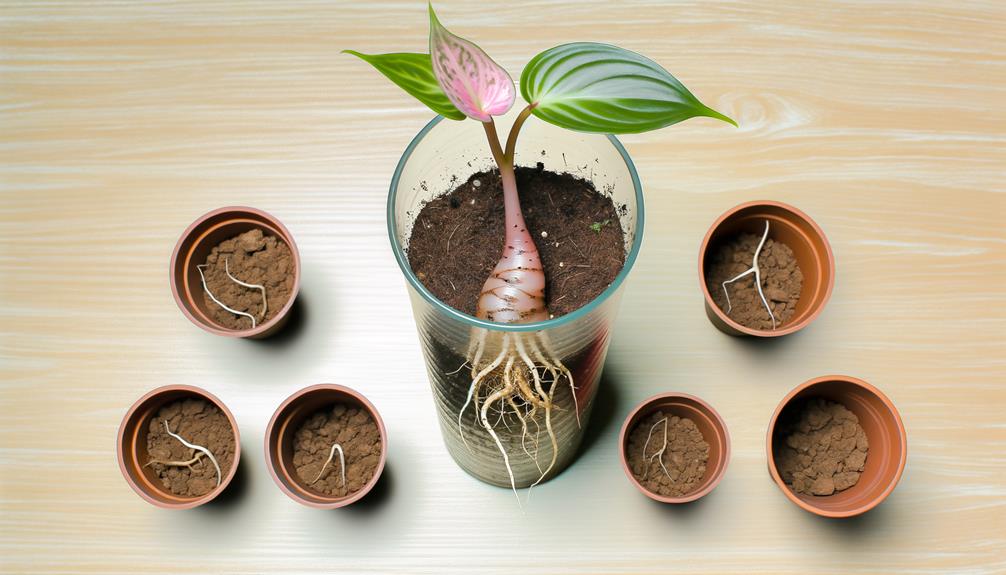
Understanding the root growth of a Pink Princess Philodendron is essential, as it directly influences the plant's overall health and the best pot size required for its development. This aroid species typically exhibits a moderate to fast root expansion characterized by a fine, fibrous root system. The roots thrive in well-aerated, nutrient-rich substrates, necessitating a balance between moisture retention and aeration.
Observing root density and health is important; healthy roots are white and firm, whereas signs of distress include browning and mushiness. A pot that is too small can constrain root growth, leading to stunted development and nutrient deficiencies. Conversely, an oversized pot can cause over-watering issues. Therefore, selecting a pot that allows modest, incremental root expansion is essential for optimal growth.
Importance of Drainage
Ensuring proper drainage is crucial for maintaining the health of a Pink Princess Philodendron. It directly impacts root aeration and prevents waterlogging. Effective drainage facilitates oxygen availability to the roots, promoting robust growth and preventing anaerobic conditions that can lead to root rot.
Waterlogging suffocates the roots and fosters pathogenic fungal activity. To achieve the best drainage, selecting a pot with multiple drainage holes is advisable. Additionally, integrating a well-draining potting mix, such as one containing perlite or orchid bark, can greatly enhance water movement and prevent compaction.
Regularly monitoring the moisture levels and allowing the top layer of soil to dry out between waterings will further mitigate the risk of excess moisture, ensuring a thriving plant.
Choosing the Right Material
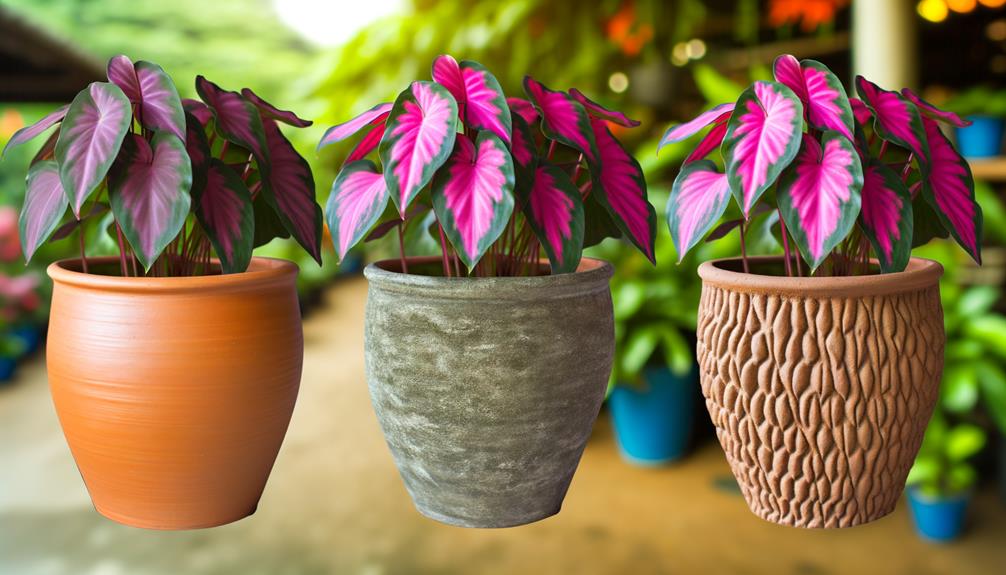
When selecting the best pot material for a Pink Princess Philodendron, one must weigh the benefits of plastic versus terracotta.
Plastic pots are lightweight and retain moisture effectively, whereas terracotta offers superior drainage and aeration due to its porous nature.
Additionally, the weight and stability of terracotta can provide better support for larger plants, reducing the risk of tipping.
Plastic Vs. Terracotta
Selecting between plastic and terracotta pots for a Pink Princess Philodendron involves evaluating factors such as water retention, root aeration, and material weight. Plastic pots are lightweight and retain moisture longer, reducing the frequency of watering. However, terracotta pots offer superior root aeration due to their porous nature but tend to dry out more rapidly. The choice depends on the specific environmental conditions and the grower's ability to manage watering schedules.
| Factor | Plastic | Terracotta |
|---|---|---|
| Water Retention | High | Low |
| Root Aeration | Moderate | High |
| Material Weight | Light | Heavy |
| Durability | High | Moderate |
Balancing these aspects will ensure optimal growth conditions for the Pink Princess Philodendron.
Drainage and Aeration
Understanding the finest material for drainage and aeration is crucial for maintaining the health of a Pink Princess Philodendron, as it directly impacts root oxygenation and moisture levels.
Terracotta pots, with their porous structure, facilitate ideal airflow and prevent waterlogging by allowing excess moisture to evaporate. This characteristic supports root respiration and mitigates risks of root rot.
Conversely, plastic pots, though lightweight and moisture-retentive, require additional consideration. Implementing drainage holes and using a well-aerated soil mix, such as one incorporating perlite or orchid bark, can enhance aeration within plastic containers.
Ensuring proper drainage and aeration through material selection and soil composition is pivotal for sustaining the Pink Princess Philodendron's vibrant foliage and overall vigour.
Weight and Stability
The weight and stability of the pot are critical determinants in ensuring the Pink Princess Philodendron remains upright and secure, particularly as the plant matures and its foliage becomes more substantial. Heavier materials, such as ceramic or terracotta, provide a low center of gravity, mitigating the risk of toppling. These materials also offer better insulation against temperature fluctuations, promoting root health.
Conversely, lightweight plastic pots, while easier to handle, may require additional stabilization methods, such as placing them within heavier decorative containers. Practical advice includes selecting pots with a broad base to enhance stability and considering the mature size of the plant to anticipate its future weight distribution.
Ultimately, material choice should balance aesthetics, functionality, and plant health.
Ideal Pot Dimensions
When selecting the perfect pot dimensions for a Pink Princess Philodendron, it is important to think about root growth space to prevent root-bound conditions and guarantee best plant health.
Sufficient drainage holes are vital to avoid waterlogging and root rot, thereby maintaining proper soil aeration.
Furthermore, the pot material should support the plant's growth needs while enhancing the overall care routine.
Root Growth Space
Perfect root growth space for a Pink Princess Philodendron typically requires a pot with a diameter of 6 to 8 inches to provide adequate room for the plant's expanding root system. This dimension allows for prime nutrient uptake and water absorption, promoting robust growth.
Excessively large pots may lead to water retention issues, increasing the risk of root rot. Conversely, undersized pots can constrict root expansion, stunting plant development. A 6 to 8-inch pot strikes a balance, enabling sufficient aeration and preventing overcrowding.
Monitoring root health periodically is advisable to sustain the plant's thriving state. Additionally, repotting every 1-2 years can help accommodate ongoing root growth, maintaining the plant's essentiality and aesthetic appeal.
Drainage Hole Importance
Ensuring proper drainage through the inclusion of drainage holes in the pot is essential for maintaining the health of a Pink Princess Philodendron, as it prevents waterlogging and facilitates ideal root oxygenation. Waterlogged conditions can lead to root rot, a detrimental condition characterized by decaying roots and impaired nutrient uptake. Best pot dimensions should include adequate space for growth while ensuring effective drainage.
| Pot Size (Diameter) | Number of Drainage Holes |
|---|---|
| 4-6 inches | 3-4 |
| 8-10 inches | 5-6 |
| 12+ inches | 7-8 |
Proper drainage not only assists in maintaining a balanced moisture level but also enhances the overall root health. Hence, the inclusion and correct number of drainage holes are non-negotiable for a thriving Pink Princess Philodendron.
Pot Material Choices
Choosing the right pot material is as essential as ensuring proper drainage, as it greatly impacts the water retention, aeration, and temperature regulation necessary for the best growth of a Pink Princess Philodendron.
Terra cotta pots are highly recommended due to their porous nature, which enhances soil aeration and prevents root rot. Conversely, plastic pots retain moisture longer, making them suitable in drier environments but potentially problematic in humid conditions.
Ceramic pots, often glazed, offer aesthetic appeal and moderate moisture retention but can be heavy and less breathable.
When selecting pot dimensions, aim for a diameter 2-4 inches larger than the plant's root ball to allow for growth while preventing excess soil that could lead to waterlogging.
Repotting Frequency
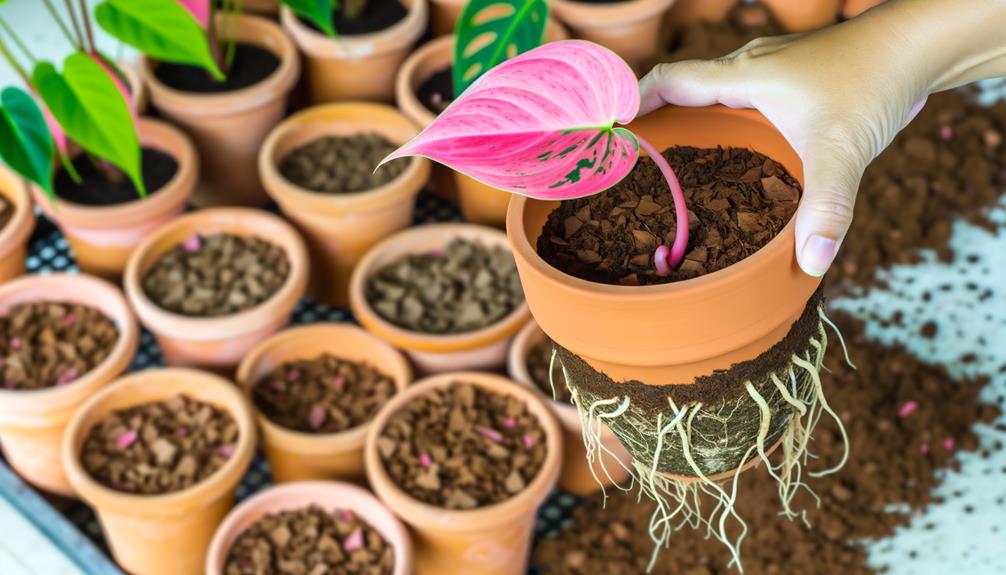
To maintain ideal growth and health, the Pink Princess Philodendron typically requires repotting every 12 to 18 months. This timeframe ensures that the plant has sufficient space for root expansion, nutrient uptake, and best air circulation within the root system. Regular repotting mitigates the risk of root-bound conditions that can inhibit growth and lead to physiological stress.
Key considerations for repotting frequency include:
- Root Development: Continuous growth necessitates periodic reassessment of root space.
- Soil Degradation: Over time, soil structure breaks down, affecting drainage and nutrient availability.
- Growth Patterns: Monitoring the plant's overall health and growth rate can inform repotting schedules.
Signs You Need a Bigger Pot
Observing specific indicators such as limited root growth, reduced water absorption, and slowed overall plant development can signal the need for a larger pot for your Pink Princess Philodendron. When roots begin to encircle inside the pot, this indicates cramped space, hindering nutrient uptake. Additionally, if water accumulates on the surface instead of being soaked up, this suggests compacted soil, requiring a larger container. A noticeable decrease in new leaf production or stunted growth also indicates insufficient space for root expansion.
| Indicator | Description |
|---|---|
| Limited Root Growth | Roots encircling the pot interior |
| Reduced Water Absorption | Water accumulating on the soil surface |
| Slowed Plant Development | Diminished leaf production and stunted growth |
Monitoring these signs ensures ideal conditions for your plant's health and essentiality.
Potting Mix Considerations

Ensuring the ideal growth environment for your Pink Princess Philodendron not only involves selecting the appropriate pot size but also demands careful attention to the composition of the potting mix.
Best growth is achieved with a well-draining substrate that retains sufficient moisture without becoming waterlogged. A balanced mix typically includes components that enhance aeration and prevent compaction.
Consider the following components for an ideal potting mix:
- Peat Moss: Provides moisture retention while maintaining a lightweight structure.
- Perlite: Enhances aeration and drainage, preventing root rot.
- Bark Chips: Adds organic matter and improves the potting mix's texture.
Conclusion
Coincidentally, the best pot size for a Pink Princess Philodendron aligns with its root growth patterns and drainage requirements. A pot with a diameter of 6-8 inches, preferably made from breathable materials like terracotta, guarantees sufficient space and aeration.
Frequent repotting, approximately every 1-2 years, prevents root-bound conditions. Observing root protrusion or slow growth can indicate the need for a larger pot.
Using a well-draining potting mix further promotes healthy development, creating a perfect growth environment.

